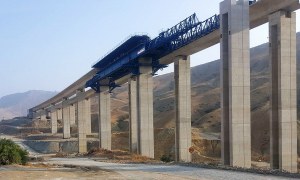🕑 Reading time: 1 minute
The effect of environmental conditions on the selection of foundation types for bridges over water is discussed. The design of foundation for bridges over water is a challenging and tedious task and the designer would encounter extreme problems. The most crucial factor that may control the design of bridges over water is environmental conditions rather than ground condition unlike the design of bridge foundation on land which govern by ground condition. Therefore, it is considerably significant to understand the environmental conditions that govern over water bridge design and specify their influence on the selection of foundation types and their construction methods.
Fig.1: Bridge Foundation Over Water

Effect of Environmental Conditions on Foundations for Bridges
Environmental factors that affect the selection of over water foundation types and their construction methods are discussed below:- Exposure conditions and water depths
- Sea or river current
- Ship collision
- Floating ice
- Earthquakes
Exposure Conditions and Water Depths of Bridge Foundations
When bridge structure is constructed in open waters of broad bay crossing, it is commonly exposed to strong currents and wind. This aggressive condition leads to undesired influences, such as, deteriorating uncompleted structure and restricting the operation period of floating construction plant. This undesired condition encourages the utilization of sizable prefabricated structural members. For example, open well caissons and box caissons. The caisson units are commonly floated and transported to the bridge construction site. After that, they are submerged and placed on the prepared bed or piles.
Fig.2: Open Caisson Sunk on Prepared Bed
Box caisson can be employed for the case where sea water is sufficiently deep for box caisson floatation. Weather condition plays significant role during transportation of the caisson box to the bridge construction site, sinking and installation of caisson units. So, it is necessary to consider possible delay in construction due to poor weather condition into account. As far as open well caisson is concerned, it is suitable for shallow water in which shallow draft bottom section is floated and moved to the construction site and submerged by taking out the soil from the open wells while the walls are lifted gradually. It is worth mentioning that the construction process of open well caisson is more sensible to the effect of weather conditions compared to the installation process of box caisson units. The box caisson construction can be carried out in considerably short period of time unless poor weather condition halt installation operation.Effect of Sea or River Current on Bridge Foundation
Piles or piers may be subjected to drag force which is generated by sea or river current. This force creates scour holes in locations where the soil is vulnerable to erosion at sea bed level. The presence of these holes around cofferdams are undesired since it generates circular movement of water in this location because of temporary conditions such as partially driven sheet piles. Current drag force is likely to create issues while sheet piles or bearing piles are installed. This is because such force at high velocities oscillates and consequently damages the pile prior to placement of pile caps or temporary grit provision which prevents the pile oscillations.Effect of Ship Collision on Bridge Foundation
Collisions are likely to occur due to ships, which are out of control and possibly cause bridge pier failure. In specific broad estuaries, deep water channel may swing from one side to another in a considerably short time and almost all piers of the constructed bridge would be at risk. The collapse of the old Sunshine Skyway Bridge in 1980 due to collision of a vessel with one of the piers of the bridge is a realistic example of ship collision risk.
Fig.3: Collapse of the Old Sunshine Skyway Bridge

Fig.4: Failure of old Sunshine Skyway Bridge in 1980 due to collision of a vessel with one of the piers of the bridge
So, it is necessary to take necessary measures to prevent the danger of ship collision to piers. These precautions would certainly increase the total cost of foundation construction. Examples of precautions against ship collision include providing artificial island around the pier to stop vessel prior to collide with bridge pier. This protection measure should be considered for piers in shallow water.
Fig.5: Penang Island Bridge Piers are Protected from Ship Collision by Providing Artificial Island

Fig.6: Details of Artificial Island Surrounding Bridge Piers to Protect the Pier Against Ship Collision
If artificial islands are constructed in deep water, the amount of stones used for wave protection and mattresses employed against scouring would be inevitably large and it would create problems for water navigation. Another protection measure is the provision of fender piles which are commonly connected by large ring beam. The ring beams should be distant from the pier to permit pier deflection while they swallow kinetic energy of moving vessel and make it to stop.
Fig.7: Provision of short piles around piers as a protection consideration against ship collision, Sunshine Skyway Bridge

Fig.8: Protecting Pier Bridge Against Ship Collision


